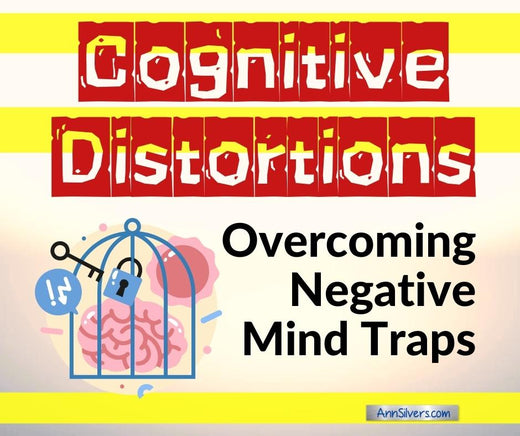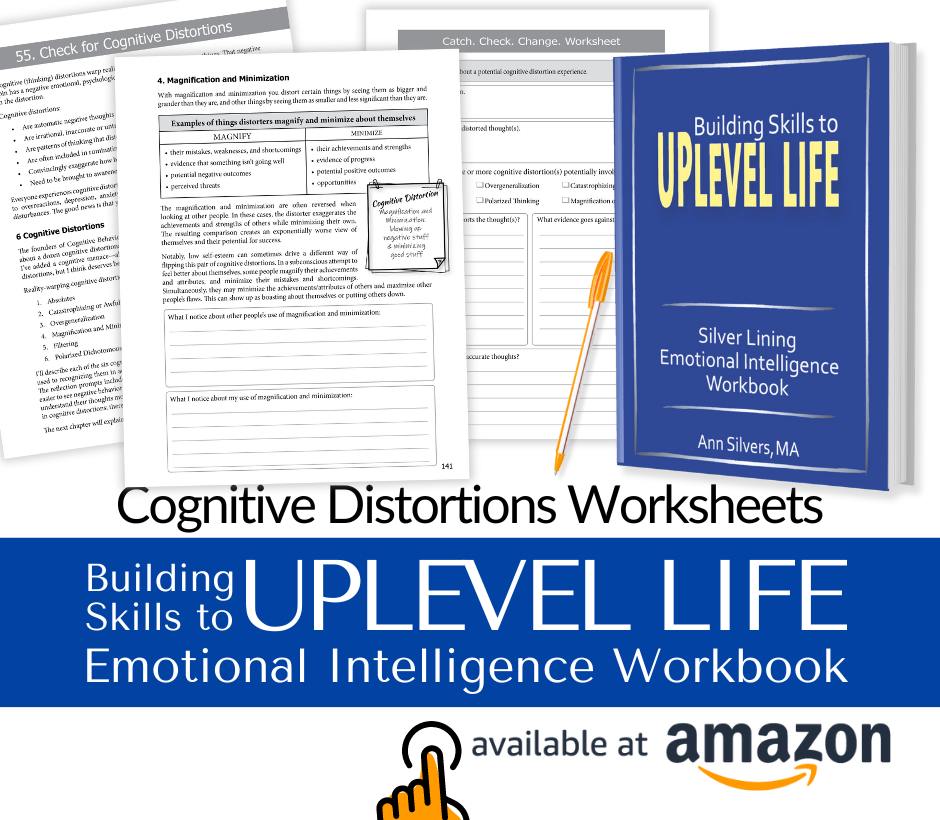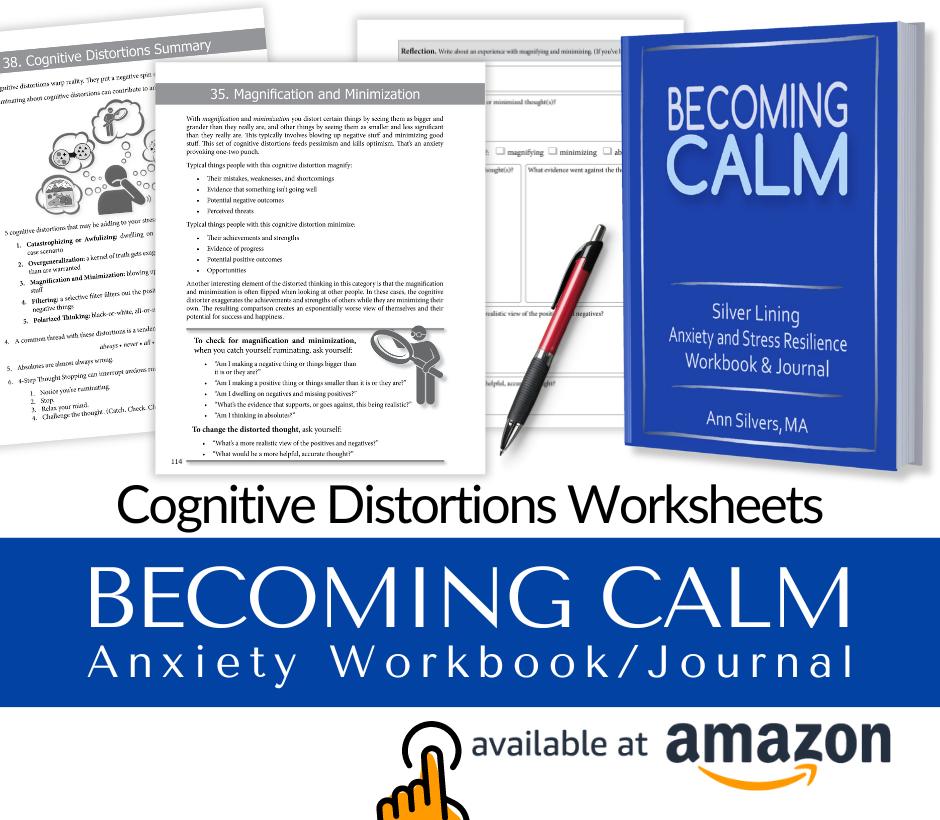Cognitive Distortions: Overcoming Negative Mind Traps

The way you look at things may be making those things feel worse than they really are. Your view of yourself and the world around you can get distorted by negative thinking patterns that are so common that they have a name: cognitive distortions.
Learning how to spot cognitive distortions like polarized thinking, overgeneralization, and catastrophizing can lift your mood and help reduce stress, anxiety, and depression. It can improve your relationships too!
Contents Overview: Understanding Cognitive Distortions
| Cognitive Distortion Definition |
| Cognitive Distortion Example Statements |
| Cognitive Behavioral Therapy (CBT) for Cognitive Distortions |
| What are Cognitive Distortions? |
| The Effects of Cognitive Distortions on Your Mental Health and Relationships |
| Negative Distorted Rumination: Fuel for Anxiety Disorders and Depression |
| The Neuroscience Behind Cognitive Distortions |
| Cognitive Distortions: The Big List |
| Definitions for 5 Common Cognitive Distortions |
| Why Terms Like “Always” and “Never” Are Red Flags for Cognitive Distortions |
| CBT Technique for Cognitive Restructuring: Catch, Check, Change |
| CBT Cognitive Distortions Worksheets: Print and Downloadable Workbooks |
Cognitive Distortion Definition
Cognitive distortions are habitual ways of viewing yourself and the world that make things look worse than they are.
Cognitive distortions distort reality.
These thinking errors put a negative spin on things. That negative spin has a negative emotional, psychological, and behavioral impact on the individual who is trapped in the distortion.
Cognitive Distortion Example Statements

Cognitive distortions can cloud our judgment and lead us to make sweeping negative conclusions about ourselves and our circumstances.
Here are some examples of cognitive distortion thoughts, illustrating how these patterns can shape our perceptions and emotions:
"If I don’t get an A on this test, I’m a complete failure."
"I didn’t get the job I interviewed for, so I’ll never find a job I like."
"I received great feedback from my boss, but I can’t stop thinking about that one comment she made about my presentation."
"Sure, I finished the project ahead of schedule, but that doesn’t matter because I made a small mistake."
"I texted my friend, and she didn’t reply right away. She must be mad at me."
Cognitive Behavioral Therapy (CBT) for Cognitive Distortions

Aaron Beck, the founder of Cognitive Behavioral Therapy (CBT), introduced the concept of cognitive distortions in the 1970s. He emphasized how these thought patterns distort reality, fuel emotional distress, and perpetuate cycles of depression and anxiety.
Beck described cognitive distortions as making people create a negative bias against themselves.
David Burns later built on Beck’s foundational work, expanding the list of cognitive distortions and making the concept more accessible to the public through his bestselling book Feeling Good: The New Mood Therapy published in 1999.
Correcting these errors in thinking have continued to be important components of CBT and general approaches to therapy. In the years following Beck and Burns, other CBT practitioners have added to the cognitive distortions list.
What are Cognitive Distortions?
Cognitive distortions twist how we see ourselves, others, and the world around us. These thought patterns are often automatic and deeply ingrained, causing us to view situations through a negative, distorted lens without even realizing it.
Cognitive distortions:
- Are automatic negative thoughts (also known as ANTs)
- Are irrational, inaccurate or untrue, and judgy—of yourself and others
- Are patterns of thinking that distort reality, how you see yourself, and how you see others
- Are often included in ruminating
- Convincingly exaggerate how bad something is
- Need to be brought to awareness so they can be taken through a reality check
The Effects of Cognitive Distortions on Your Mental Health and Relationships
Everyone experiences cognitive distortions sometimes, but if left unchecked, they can warp how you see events, yourself, and other people. They can undermine your personal well-being and relationships.
How Cognitive Distortions Hurt You Personally
Cognitive distortions can severely impact your emotional well-being and mental clarity.
Here's a few of the many downsides to these negative thought patterns:
- Exaggerate your mistakes and shortcomings
- Lower your self-esteem
- Feed negative rumination
- Trigger anger and anxiety
- Fuel depression
- Create roadblocks for personal and career growth
They promote a negative outlook on yourself and the world that can contribute to depression, anxiety, anger, and other mental and emotional disturbances.
How Cognitive Distortions Hurt Relationships
Cognitive distortions can make you think of your partner more negatively than warranted.
The twisted thinking triggers overreactions, creates misunderstandings, and breeds confusion that damages relationships.
Negative Distorted Rumination: Fuel for Anxiety Disorders and Depression
People with anxiety and depression tend to get stuck in psychological distortions. That stuckness shows up as ruminating or dwelling on the negative thoughts. The ruminating creates a consuming whirlwind that will make you more and more panicked, anxious, nervous, worried, depressed, and stressed.
Training your brain to catch, check, and change faulty thinking patterns can reduce your anxiety, relieve your depression, and increase your well-being.
(I'll provide more on the 3-C's cognitive behavioral method for dealing with thinking errors later in this post.)
The Neuroscience Behind Cognitive Distortions

Cognitive distortion negative thinking traps are not just a matter of mindset. They are deeply embedded in the brain’s wiring.
Neuroscientific research has identified key areas of the brain involved in these maladaptive thought processes, particularly the prefrontal cortex and the amygdala.
The prefrontal cortex (PFC) is the brain’s control center for reasoning, decision-making, and executive function.
The amygdala governs emotional responses, especially those related to fear and stress.
When someone experiences a cognitive distortion, like catastrophizing or all-or-nothing thinking (more on those in a minute), the brain's emotional centers, especially the amygdala, can dominate the more rational parts of the brain. This imbalance can make it hard to think logically in stressful situations.
Research: Stress and Its Effect on Logical Thinking
A profound take-away tidbit from a continuing education mental health counseling class I took a few years ago gave me: The anxious brain is not a problem-solving brain.
Research shows that stress can get in the way of your brain's ability to be logical. Stress can decrease prefrontal cortex activity, leading to three negative outcomes:
- Impulsive or exaggerated emotional responses
- Difficulty challenging negative thoughts
- Problems regaining emotional balance after distressing events
Research: How Negative Thinking Strengthens Worry Networks
Researchers studying brain activity reveal that chronic negative thinking can strengthen the brain's worry networks.
Repetitive distorted thinking stimulates the default mode network (DMN), which is involved in thoughts about ourselves and our experiences.
DMN hyperactivity has been linked to ruminating on negative thoughts. Over time, this can create neural pathways that make negative thinking habitual, reinforcing cognitive distortions.
Cognitive Distortions: The Big List

The list of cognitive distortions has swollen over the years. I'll present a list here that includes the ones I could easily find being talked about online, then we'll focus on the five I see most often.
To me, the long list becomes difficult to digest for useable learning and integrated change. It also represents a lot of overlap, where a distortion label may be simply explained within another.
Here's the expanded cognitive distortions list. A couple of them have sublabels within the labels. These may show up on some lists separately.
-
Catastrophizing or Awfulizing
-
Overgeneralization
-
Magnification and Minimization
-
Filtering
-
Polarized Thinking
-
All-or-Nothing Thinking
-
Disqualifying the Positive
-
Jumping to Conclusions (Mind Reading, Fortune Telling)
-
Emotional Reasoning
-
Should Statements
-
Labeling and Mislabeling
-
Personalization and Blame
-
Tunnel Vision
-
Fallacy of Fairness
-
Fallacy of Change
-
Control Fallacies (Internal Control Fallacy, External Control Fallacy)
-
Heaven’s Reward Fallacy
-
Always Being Right
I won't cover all the distortions listed above in this post, but I provide short descriptions and examples of each in another post: 18 Cognitive Distortions That Can Twist Your Thinking.
In the next sections, I'll focus on the first five cognitive distortions on this list. These are the CD's I see most frequently.
Definitions for 5 Common Cognitive Distortions
Here are definitions for the five cognitive distortions I see in clients most often:
-
Catastrophizing or Awfulizing: dwelling on an exaggerated, worse-than-worst-case scenario
-
Overgeneralization: a kernel of truth gets exaggerated to cover more circumstances than are warranted
-
Magnification and Minimization: blowing up negative stuff and minimizing good stuff
-
Filtering: a selective filter filters out the positive things that happen and keeps the negative things
-
Polarized Thinking: black and white, all-or-nothing, dichotomous thinking

Why Terms Like “Always” and “Never” Are Red Flags for Cognitive Distortions
It is noteworthy that a common thread with many distorted thought processes is a tendency to think in absolutes:
- always
- never
- all
- none
Absolutes are almost always wrong.
When they're wrong, absolutes make things feel worse than they really are. "My partner is always late" feels worse than "My partner is sometimes late" or "My partner is late this time." It even feels worse than "My partner is often late."
Describing things or people in extreme terms will make you feel like those things or people are globally bad, rather than seeing the isolated things that might be bad.
Absolutes also make you think that things will never be better, rather than allowing you to recognize that while something might be bad now, it may be better in the future.
Absolutist thoughts contribute to catastrophizing, overgeneralization, magnification and minimization, filtering, and polarized thinking.

What to Do: Begin to notice when terms like always, never, all, or none are part of your thoughts. Ask yourself:
-
Does the absolute term really fit the situation?
-
What would be a better description of how often the thing happens?
-
Are they contributing to other distortions like magnification and minimization or awfuling?
CBT Technique for Cognitive Restructuring: Catch, Check, Change
It’s possible to shift your thinking and break free from cognitive distortions.
The CBT technique of the 3 C's—Catch, Check, Change—offers a straightforward approach to challenge and reframe those negative thoughts.
It's a form of cognitive restructuring: a therapeutic process used to identify, examine, and change negative or distorted thought patterns. It helps rewire your brain over time, forming healthier mental habits and breaking cycles of negativity.
While this method is simple, it requires you to consciously engage with the 3-step method as you build new neural pathways and weaken the old ones.
Cognitive distortions can be challenged using the 3 C's: Catch, Check, Change.
1. Catch
Identify the thought that came before a painful emotion or was spinning in your head as you began ruminating on something negative.
2. Check
Reflect on how rational, accurate, and useful the thought is. Question whether it is based on overreactions or cognitive distortions.
3. Change
Replace the thought with something more accurate and useful.
CBT Cognitive Distortions Worksheets: Print and Downloadable Workbooks
Cognitive distortions come up in therapy a lot.
They are such a common issue, and addressing them is such an important part of improving personal and relationship well-being that I've created two sets of products for you to learn more about cognitive distortions and use the Catch, Check, Change method to challenge them: Downloadable targeted PDFs and Print Workbooks for anxiety and emotional intelligent life.
1. Cognitive Distortions Downloadable PDF Worksheet Workbooks
My new downloadable pdf CBT workbook series, available on my AnnSWellnessDigitals Etsy store, includes cognitive distortion information pages and worksheets in workbooks covering individual cognitive distortions and an all-encompassing workbook bundle.
- Individual Cognitive Distortion Workbooks: These 13–page workbooks cover Catastrophizing or Awfulizing, Overgeneralization, Magnification and Minimization, Filtering, and Black-and-White, Polarized Thinking. They can be printed or used digitally on your devices as easy-to-use fillable forms.
- Cognitive Distortion Bundle: This 28-page Cognitive Distortions CBT Coping Skills Workbook printable pdf bundle covers all five of the cognitive distortions mentioned in this post. Note: This one is formatted for print only, not as a digital fillable form.
👉 Ready to take the first step in challenging negative thinking patterns? Explore these workbooks and start creating healthier thought habits today.
If you prefer print books, check out the ones below.
2. Emotional Intelligence and Anxiety Print Workbooks
Two of my comprehensive print workbooks include information and exercises for identifying and overcoming cognitive distortions. Each of these books provides different opportunities for working with your cognitive distortions and using the Catch, Check, Change method to challenge them:
Building Skills to Uplevel Life: Silver Lining Emotional Intelligence Workbook
Becoming Calm: Silver Lining Anxiety and Stress Resilience Workbook and Journal
👉 Start your journey to emotional intelligence and resilience! These workbooks offer tools to help you develop skills, reduce stress, and foster personal growth. Check them out and take the next step toward a calmer, more balanced life.
Note: This post should not be taken as therapy. It is always advisable to seek individualized care with a mental health professional.
- Ann Silvers










Comments 0